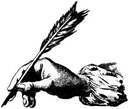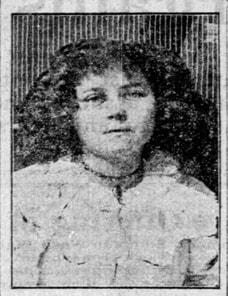 By M.P. Pellicer | Stranger Than Fiction Stories It was a spring day in 1903 when the body of Bertha "Glory" Whalen was found in a thicket. Her family had last seen her when she left for school. 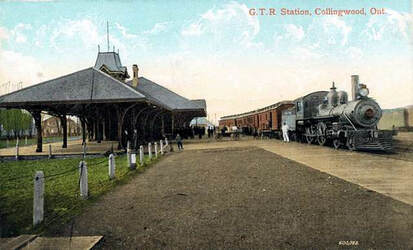 Grand Trunk Railway, Collingwood, Ontario c.1910 Grand Trunk Railway, Collingwood, Ontario c.1910 Collingwood, Ontario, 1903 The Grand Trunk Railroad seemed destined to be the site of dark occurrences the year of 1903, starting in January. Octave Trembly a railway conductor was killed in a rear end collision between two freight trains at the Victoria Bridge. Trembly was on the platform of the caboose when the shock of the collision came, and he was caught between the ends of both cars. He was cut in two and decapitated. Two months later Joe Trembly's, 4-year-old son, unknown if he was a relation of the unlucky conductor was burned while he was playing with matches. A neighbor put the fire out, and submerged him in a nearby pond, however the boy died from his injuries. On a Spring day in May, Glory Whalen's body was found in the woods alongside the railway station. Steps had been erected over the fence so pedestrians could take a short cut to the cemetery. She was murdered about 50 feet from the steps. She had left for East Ward Public School about 8 a.m., and it was not until she failed to return home that her parents realized something was wrong. Along with neighbors they started a search which lasted until 3 a.m. It wasn't until 7 a.m. that Russell Kendell (Kendall) who lived on the adjoining farm found the girl's body lying among the wild flowers, under thickly overhanging trees. 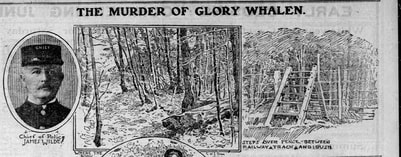 Illustration of where Glory Whalen was attacked c.1903 Illustration of where Glory Whalen was attacked c.1903 The child was blindfolded with a handkerchief, and her skull had been fractured by a blow that left the bone protruding. Her school books, parasol and lunch were close by. She was dressed in black velveteen, with a straw hat. Later it was believed the handkerchief was used as a gag, however one thing was certain, it was tied over her face when she was killed. It had powder burns such as a bullet would make. Her parents lived on the Poplar Side Road that adjoined G.B. Westcott's farm. She was accustomed to taking this road to and from school every day. The place where she was killed was only 100 yards from the Kendell house, but it was hidden by a high board fence. The coroner and a reporter found a cedar club nearby which was likely the murder weapon. The cudgel had been freshly cut from a tree, and it was nearby with gashes on it. A gray sock was discovered by Chief Wilder, and it was theorized that someone had waited for Glory. Someone who knew her habits, and perhaps even knew her. It was a whole, clean sock of good country wool that contradicted the suspicion that a tramp was her attacker. Glory's murder was compared to that of Jessie Keith in 1894, a 13-year-old killed when she had gone to purchase groceries and was on her way home along the railway track. She was seized by Almeda Chattelle, a "tramp of eccentric habits" who dragged her through a field, raped and killed her. He hid her body in a bush, and like Glory she was not missed until she did not return home. Chatelle was seen at several paces in Western Ontario. He stole a valise and disguised himself as a woman in order to escape. He was caught, tried and hanged for the crime. 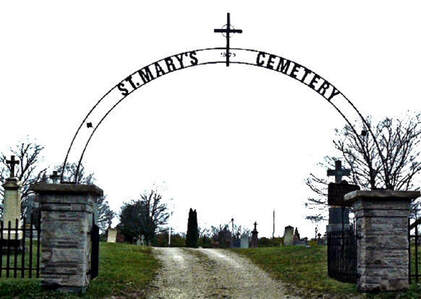 St. Mary's Cemetery, Collingwood, Ontario present day St. Mary's Cemetery, Collingwood, Ontario present day Glory was buried on June 1, 1903. The procession was a mile and a half long. Father O'Leary delivered the sermon. He said, "The angel of heaven must have wept as the inhuman assailant rushed down upon her. The spirits of heaven must have veiled their eyes and closed their ears to the cruel blow and the ringing shot. But for one thing we are thankful that divine Providence defended her body from insult. The innocent girl, fresh in the bloom of her girlhood was protected by her Maker. Justice requires that the perpetrator of the crime be sought out and punished for the preservation of society." The pall-beareres were Glory's three cousins, Thomas and James Connery and Herbert Smith, and Laurence Allen, John Cowie and Russell Kendell. Little did anyone who gathered at the funeral, imagine that no one would ever be brought to justice for this crime. 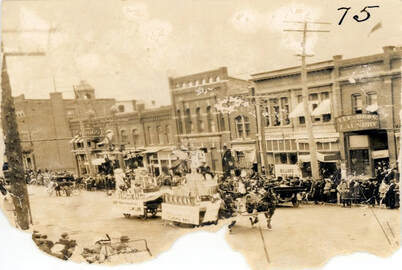 Collingwood c.1914 Collingwood c.1914 Within a week of the murder, much attention was given to her neighbor's story since he lived close to the spot where the crime was committed, and he was first person to see the body. Russell Seftor Kendell, born September 30, 1881, lived on the farm with his mother Melissa Kendell. He had hardly commenced the search on the second day, when he walked straight to the place where it was lying. He claimed he was transplanting cabbages on the morning of the murder, which he gave as a reason why he did not hear when the shot was fired. There was a hill between where the child was found and the Kendell farm. Kendell said it was a common occurrence for boys to go through the swamp shooting, and if he had heard the shot he would not have paid much attention, however he was firm that he did not hear anything. When asked if he had a revolver, he said yes, a small one. He produced a 22-caliber which was different from the bullet taken from the child's corpse.  Hurontario St c.1882 Hurontario St c.1882 The police initially were mystified for a lack of motive. Glory still had 35 cents in her possession, equivalent to about $10 in modern times. She was not raped, and her cause of death was a bullet in the brain. The police theorized that perhaps the attacker meant to rape her, but then she screamed and there was another student who was making her way along the same route to school. It was believed he hit her first over the top of the head, and then shot her. Initial suspects were an unknown peddler or tramp. A lame woman who lived in the area said she had seen two peddlers on the track. One these men came to the Kendell household, and walked into the kitchen without knocking on the door. He wore blue trousers and had a straw hat on. The police also looked into the suicide of one Eli Holmes. He came to Collingwood about a year before to build a house for Dr. McFaul, and he was awarded the contract for a new library. Holmes had a friend who he visited that lived just beyond where Glory was killed. On May 27, he was found hanging by a strap to one of the rafters in a stable on the east side of Hurontario Street. At the time of the murder he might have still been alive. It was believed he had done away with himself over family troubles as he had separated from his wife, but some wondered if his motive had something to do with Glory's murder, since she was killed on the same day he took his life. Nothing was ever found to support this theory. The autopsy revealed that Glory was in good health and well nourished. The bullet had entered behind the right ear, traversed the brain in a diagonal direction, pierced the skull in front and lodged just under the skin over the left eye. It was fired from a .38 caliber revolver. The months slipped away, and by the end of 1903, William Joseph Carey who was imprisoned for an unnatural crime in England made a false confession to Glory's murder. He originally came from Ontario, but later it was found he admitted to the crime with the hope of being taken to Canada to serve his prison time. A reward of $650 was offered, but this did not produce a lead that would identify Glory's killer. What it did produce were psychics that wanted to pass messages from the other side about who committed the crime. The story lingered in the newspapers, mostly remarking that the case was unsolved. After 10 years it faded from the newspapers altogether. 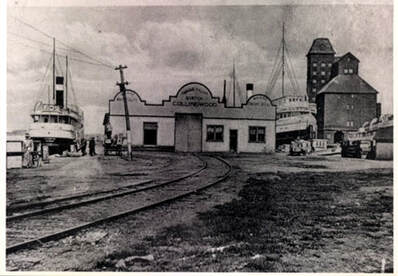 View of the Grand Trunk System wharf warehouse and freight office flanked by two steamers, ca 1910. View of the Grand Trunk System wharf warehouse and freight office flanked by two steamers, ca 1910. James Henry Whalen, Glory's father suffered what would be considered in modern terms as a nervous breakdown after his daughter's death. Not a year had passed before he abandoned his wife Frances, his four remaining children, along with the upkeep of the farm and the debts the family had accrued. In 1905, Henry Whalen was arrested on a charge of assault. There had been trouble before this, when in August in had gone to his former home and demanded some "household effects, abused the horses of the farm and insulted and assaulted his wife." His wife and son Charles provided testimony against him. He was sentenced to two months in common jail. He moved to Fort William (Thunder Bay) where he had Whalen family. He died in 1918, after battling stomach cancer for three years. It was inescapable that due to Henry Whalen's erratic behavior some started to suspect him as the person who murdered Glory, but like other theories nothing came of it. His wife Frances and his surviving children moved to Ohio in 1906. Frances Whalen died in 1933, and her body was interred in St. Mary's Cemetery in Collingwood, Canada. Glory Whalen's grave is somewhere in the cemetery, but unmarked and the exact location is not known. In June 2009, a plaque was dedicated to the memory of Glory Whalen close to where her body was found. It reads: ON MAY 27, 1903, 13-YEAR OLD GLORY WHALEN SET OUT FOR CONNAUGHT PUBLIC SCHOOL FROM HER FAMILY’S FARM ON POPLAR SIDEROAD, A 30 MINUTE WALK. GLORY NEVER REACHED HER DESTINATION. AFTER AN ALL-NIGHT SEARCH, GLORY’S BODY WAS DISCOVERED IN A THICKET OF CEDARS JUST A FEW YARDS FROM THE GRAND TRUNK RAILWAY TRACKS. THIS STONE MARKS THE LOCATION WHERE GLORY WAS FOUND, FULLY CLOTHED, HER ARMS FOLDED ACROSS HER CHEST AND HER BELONGINGS NEARBY. AN AUTOPSY REVEALED THAT THE CAUSE OF DEATH WAS A GUNSHOT WOUND. MONTHS OF FRUITLESS INVESTIGATION TURNED UP NUMEROUS LEADS, INCLUDING BIZARRE CLAIMS OF PSYCHIC KNOWLEDGE OF THE CRIME, HOWEVER NO RELIABLE EVIDENCE WAS UNCOVERED AS TO THE IDENTITY OF GLORY’S KILLER OR THE MOTIVE FOR THE CRIME. THE MURDER OF GLORY WHALEN REMAINS ONE OF THE OLDEST CASES IN THE ANNALS OF UNSOLVED CRIMES IN CANADA. GLORY WAS INTERRED IN ST. MARY’S CATHOLIC CHURCH CEMETERY. Glory's murder remains the longest unsolved homicide in Ontario’s history.
Source - The Toronto Daily Star, The Daily Standard
0 Comments
Your comment will be posted after it is approved.
Leave a Reply. |
Stranger Than Fiction StoriesM.P. PellicerAuthor, Narrator and Producer Archives
July 2024
Categories
All
|
Stories of the Supernatural
- Stories of the Supernatural
- Miami Ghost Chronicles
- M.P. Pellicer | Author
- Stranger Than Fiction Stories
- Eerie News
- Supernatural Storytime
-
Astrology Today
- Tarot
- Horoscope
- Zodiac
-
Haunted Places
- Animal Hauntings
- Belleview Biltmore Hotel
- Bobby Mackey's Honky Tonk
- Brookdale Lodge
- Chacachacare Island
- Coral Castle
- Drayton Hall Plantation
- Jonathan Dickinson State Park
- Kreischer Mansion
- Miami Biltmore Hotel
- Miami Forgotten Properties
- Myrtles Plantation
- Pinewood Cemetery
- Rolling Hills Asylum
- St. Ann's Retreat
- Stranahan Cromartie House
- The Devil Tree
- Trans-Allegheny Lunatic Asylum
- West Virginia Penitentiary
- Paranormal Podcasts
"When misguided public opinion honors what is despicable and despises what is honorable, punishes virtue and rewards vice, encourages what is harmful and discourages what is useful, applauds falsehood and smothers truth under indifference or insult, a nation turns its back on progress and can be restored only by the terrible lessons of catastrophe."
- Frederic Bastiat
- Frederic Bastiat

Copyright © 2009-2024 Eleventh Hour LLC. All Rights Reserved ®
DISCLAIMER
DISCLAIMER
 RSS Feed
RSS Feed








